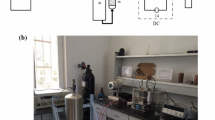Abstract
Proper dissipation of thermal energy has always been a requirement for better efficiency of a system. Fins provide additional surfaces to reject heat to the surrounding from the working faces. The current work considers the thermal analysis of pin fins of circular and drop-shaped cross section. Fins of uniform cross section are placed over a base plate arranged in a staggered manner. With an analysis of various thermal and flow parameters, the drop-shaped pin fin is found to yield a better thermal enhancement over cylindrical pin fins. Further, the drop-shaped fins are modified to make a split to enhance the interaction between the fluid and the fin surface. The modification shows slightly better result compared to existing drop-shaped fin. The modelling has been done using ANSYS FLUENT 17.1.













Similar content being viewed by others
References
M. Eren, S. Caliskan, Effect of grooves pin-fin in a rectangular channel on heat transfer augmentation and friction factor using Taguchi method. Int. J. Heat. Mass. Transf. 102, 1108–1122 (2016)
M.M. Fyrillas, T. Leontiou, Critical Biot number of a periodic array of rectangular fins. J. Heat Transf. 138, 1 (2015)
T.M. Jeng, S.C. Tzeng, Pressure drop and heat transfer of square pin-fin arrays in in-line and staggered arrangements. Int. J. Heat Mass Transf. 50, 2364–2375 (2007)
Y. Jooa, S.J. Kim, Comparison of thermal performance between plate and pin fin heat sink in natural convection. Int. J. Heat Mass Transf. 83, 345–356 (2015)
D.K. Kim, H.J. Kim, M. Lee, Nusselt number correlation for natural convection from vertical cylinders with triangular fins. Appl. Therm. Eng. 107, 768–775 (2016)
W.A. Khan, J.R. Culham, M.M. Yovanovich, Modelling of cylindrical pin-fin heat sinks for electronic packaging. IEEE Trans. Compon. Packag. Technol. 31–3, 1521–3331 (2008)
H.S. Kang, Optimization of a pin fin with variable base thickness. Int. J. Heat Transf. 132, 345 (2009)
R. Yakut, K. Yakut, F. Yesildal, A. Karabey, Experimental and Numerical Investigations of Impingement Air Jet for a Heat Sink. Procardia Eng. 157, 3–12 (2016)
F. Wang, J. Zhang, S. Wang, Investigation on flows and heat transfer characteristics in rectangular channel with drop shape pin fins. Propuls. Power Res. 1, 64–70 (2012)
K. Horiuchi, A. Nishihara, K. Sugimura, Multi-objective optimization of water-cooled pin-fin heat sinks. Int. J. Heat Mass Transf. 81, 760–766 (2015)
Author information
Authors and Affiliations
Corresponding author
Additional information
Publisher's Note
Springer Nature remains neutral with regard to jurisdictional claims in published maps and institutional affiliations.
Rights and permissions
About this article
Cite this article
Ranjan, A., Yadav, S.S. & Das, K. Thermal and Flow Analysis of Split Drop-Shaped Pin Fins for Improved Heat Transfer Rate. J. Inst. Eng. India Ser. C 101, 375–382 (2020). https://doi.org/10.1007/s40032-019-00548-4
Received:
Accepted:
Published:
Issue Date:
DOI: https://doi.org/10.1007/s40032-019-00548-4




